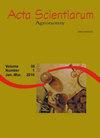连续和间歇干燥的玉米颗粒显微镜
IF 1.2
4区 农林科学
Q3 AGRONOMY
引用次数: 1
摘要
干燥作为产品保存和品质保存的一种方式,是收获后加工的重要步骤。在此背景下,本研究旨在评价玉米籽粒连续干燥和间歇干燥不同休息时间对其微观和宏观结构完整性的影响。玉米籽粒在水分含量为0.3399±0.001干基(db)时收获,连续和间歇干燥,休息时间分别为4、8、12和16小时。实验采用固定床干燥机,控制干燥空气温度为100℃,空气流量为1.5 m3 min.−1 m−2 (12 m3 min.−1 m−3)。连续干燥时水分含量为0.1628±0.0003 db,间歇干燥时水分含量为0.2195±0.0002 db,休息后继续干燥。对干燥速率、颗粒图像完整性、扫描电镜颗粒构象和细胞膜完整性进行了评价。干燥速率随休息时间的增加而增加,休息时间的增加降低了裂缝的强度,休息时间的减少导致淀粉颗粒的分散性提高,尺寸减小,细胞膜的完整性降低。本文章由计算机程序翻译,如有差异,请以英文原文为准。
Microscopy of maize grains subjected to continuous and intermittent drying
Drying is an important step in the post-harvest processes as a way of product conservation and quality preservation. In this context, this study aimed to evaluate the effect of continuous and intermittent drying of maize grains with different rest periods on the integrity of their micro- and macroscopic structures. Maize grains were harvested with a moisture content of 0.3399 ± 0.001 dry basis (db) and subjected to continuous and intermittent drying with 4, 8, 12, and 16 hours of rest period. An experimental fixed-bed dryer, with controlled drying air conditions at a temperature of 100 °C and air flow of 1.5 m3 min.−1 m−2 (12 m3 min.−1 m−3), was used. Continuous drying was completed with a moisture content of 0.1628 ± 0.0003 db, whereas intermittent drying was interrupted with 0.2195 ± 0.0002 db and resumed after rest. The drying rate, integrity through grain images, the conformation of particles through scanning electron microscopy, and cell membrane integrity were evaluated. The drying rate increased with an increase in the rest period, the increase in rest period reduced the intensity of cracks, and the reduction in rest period led to higher dispersion and reduction in the size of starch granules and lower integrity of cell membranes.
求助全文
通过发布文献求助,成功后即可免费获取论文全文。
去求助
来源期刊

Acta Scientiarum. Agronomy.
Agricultural and Biological Sciences-Agronomy and Crop Science
CiteScore
2.40
自引率
0.00%
发文量
45
审稿时长
>12 weeks
期刊介绍:
The journal publishes original articles in all areas of Agronomy, including soil sciences, agricultural entomology, soil fertility and manuring, soil physics, physiology of cultivated plants, phytopathology, phyto-health, phytotechny, genesis, morphology and soil classification, management and conservation of soil, integrated management of plant pests, vegetal improvement, agricultural microbiology, agricultural parasitology, production and processing of seeds.
 求助内容:
求助内容: 应助结果提醒方式:
应助结果提醒方式:


